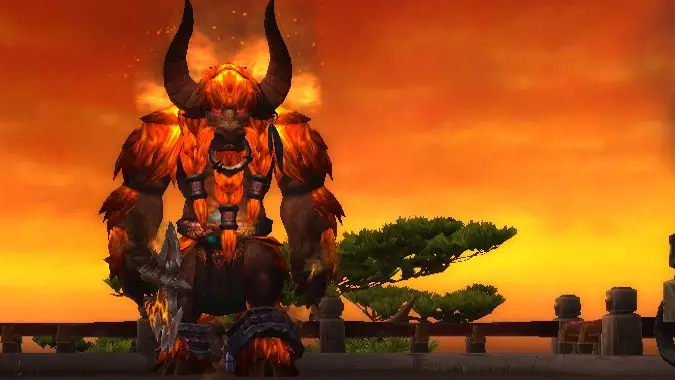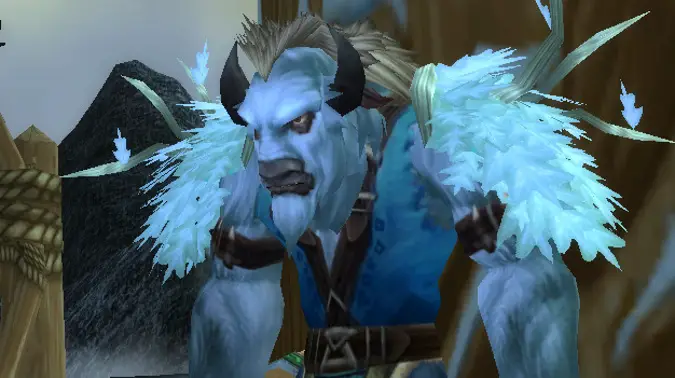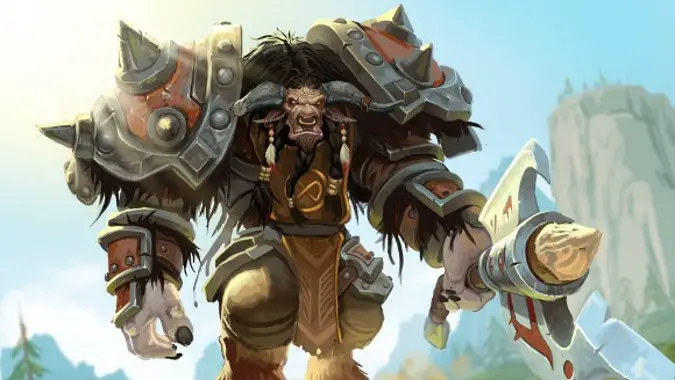Know Your Lore: History of the Tauren

The Tauren, or Shu’halo, are but one branch of an ancient lineage that spans millennia. Before the War of the Ancients and the Sundering, before the Mogu and Troll empires, there were the ancestors of the Tauren living nomadic lives in central Kalimdor. These beings were called the Yaungol. They were the progenitors of all living offshoots of the Tauren people. The modern Yaungol, the Shu’halo, the Highmountain and the Taunka and any isolated tribes not yet accounted for all spring from this singular people. A writing from the time of the Mogu Emperor Qiang called them “bovine humanoids” which indicates that they were at least superficially as they are now.
Thousands of years ago these people studied the natural world at the hooves of the demigod Cenarius, but despite his teaching, all was not well with them. The rising power of the Trolls meant that there were conflicts over territory, and eventually the Yaungol grew tired of these skirmishes and sought a new place to live. Despite Cenarius’ advice, the Yaungol headed south.

Mogu slavery
While the Trolls had been unruly neighbors, what the Yaungol endured upon their journey south was far worse. At first, all seemed well. They discovered expansive hunting grounds that were available and seemingly unused, and settled into their existence as nomadic hunters. But soon they discovered that their new lands were bordered by an Empire ruled by the heartless Mogu. Worse, the physical power of the Yaungol attracted the attention of their Emperor, Qiang the Merciless, who was intrigued by them.
The Emperor ordered the Yaungol subdued. The Mogu war machine rolled over the Yaungol tribes, crushing them with their sophistication and unity. Once the Yaungol were finally subdued, Qiang ordered the Flesh-Shapers to attempt to enhance the strength, savagery and even the intellect of the Yaungol. Perhaps he should have thought more about the possible consequences of this order, but the Flesh-Shapers carried it out.
Generations of slavery did nothing to break the Yaungol. They rose in revolt against the Mogu alongside the other races of the Empire, and broke free. But they were left forever changed by the ordeal. Much of their culture had been erased. Many of them were furious, angry at what had happened. They wanted to use force to wrench a new way of life into being. Others half-remembered tales of Cenarius to guide them on a different path.

Tribes fragment
Eventually a decision had to be made. Whatever their differences of opinion, the Yaungol did not seek a war with one another. They were still one people. Even after the work of the Flesh-Shapers had wrenched them into larger, stronger, more aggressive beings than they had been, they recognized their shared kinship. Rather than fight, they each went their separate ways.
Some remained in the lands that we today know as Pandaria. Most of these were of the more aggressive faction. They grew more hostile to the other races they shared the region with as time passed. These Yaungol saw nature as an opponent that had to be subdued. They used fire and flaming oil as weapons in this regard. In time, they came to revere fire itself as a symbol of this conquest. The modern-day Yaungol of the Townlong Steppes, Kun-Lai Summit and the Timeless Isle are all examples of these Yaungol. However, the Yaungol of the Timeless Isle may be said to be closer to the primordial origin of all their people as a result of their isolation on the island.
It’s unclear what role Ordos had in Yaungol history. But as a shaman who pledged himself to the Fire Lords in exchange for a kind of immortality as a demigod, he may well have been the one who introduced fire worship to the Yaungol.

The path of ice
Some of the ancient Yaungol were no more interested in Cenarius or his ideas than those that remained in the south. They just didn’t wish to linger in the land of their slavery. So they headed north, but kept traveling well past their original homes in central Kalimdor. Eventually, they reached the furthest extent of the continent. There they settled in the land we today call Northrend.
These nomads were affected by the proximity to the Titan-Forged machines of the Storm Peaks. Much as their old kin now sought to conquer nature with fire, these nomads too sought dominion over the natural world. But theirs was a land of ice and they changed to suit it, becoming known as the Taunka. Their shamans were just as brutal as the Yaungol in some ways. They also sought dominion over the elements. But they were much more at home in their frosty new home, and didn’t resort to fire worship.
The Taunka also managed to live with less open conflict with their neighbors. They certainly endured skirmishes, but until the coming of the Lich King the Taunka managed to coexist with groups like the Nerubians, Furbolg and Vrykul without often coming to blows. After the rise of the Lich King, however, the Taunka suffered as much as any. Today, many have joined the Horde to secure allies against the Scourge.

The Shu’halo return
Those tribes that returned to central Kalimdor and found Cenarius again became known as the Shu’halo. Just as the Yaungol had been changed by the Flesh-Shapers and the Taunka further changed by exposure to Titan-Forged constructs, the Shu’halo found themselves altered by the power of the Well of Eternity. They returned to Cenarius’ tutelage and learned much of the natural world and its ways from him. Even still, they were marked by their own changed natures.
But in the Earth-Mother they found what the Yaungol and the Taunka lacked. A means to balance their power and rage against a more peaceful way of life. The Shu’halo managed to reach a place where all the elements came together, where dominance wasn’t necessarily the goal. They didn’t seek to conquer the natural world or force it to their will, but rather to live as part of it. Still, for years, all of the Tauren were in contact with one another. Taunka, Shu’halo and Yaungol alive, no matter how isolated they were from one another, kept in contract, made trade, sent envoys. As different as they had become, they knew they were still one people.
Then the demons came, and Azeroth changed. And the Tauren all had to change with her.
Please consider supporting our Patreon!
Join the Discussion
Blizzard Watch is a safe space for all readers. By leaving comments on this site you agree to follow our commenting and community guidelines.
 @MatthewWRossi
@MatthewWRossi




